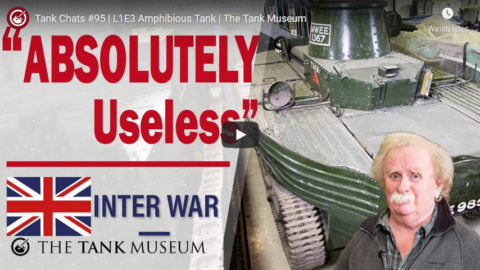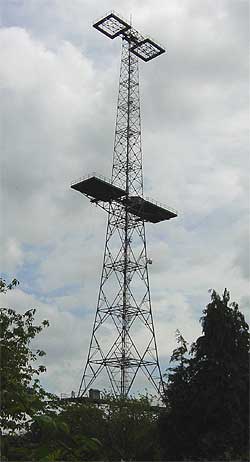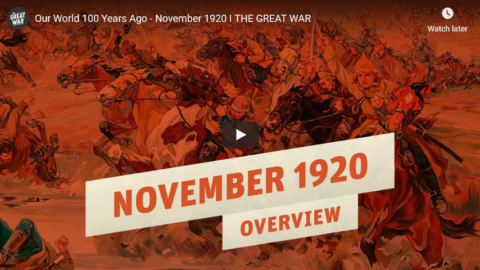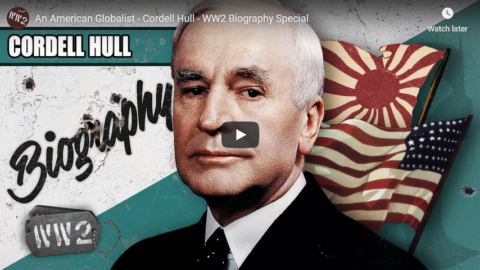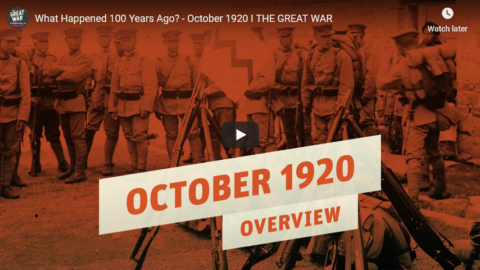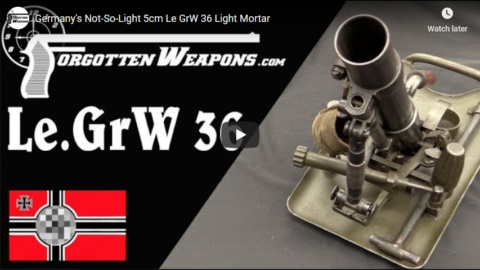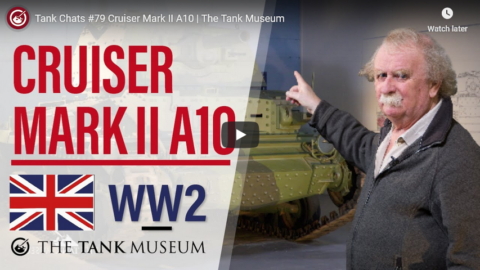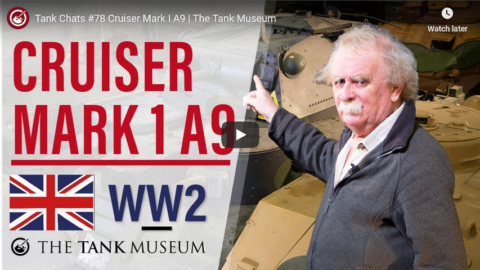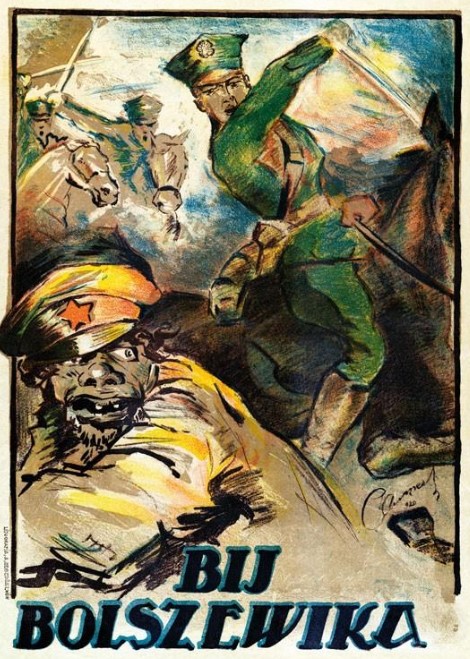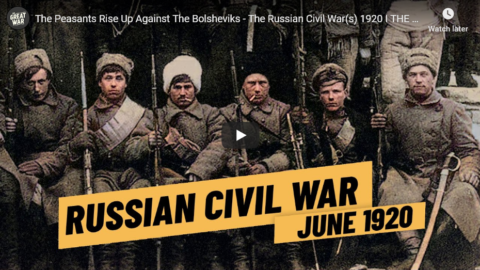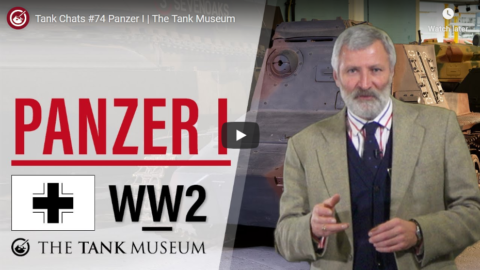The Tank Museum
Published 21 Feb 2020Here David Fletcher examines the Vickers-Carden-Loyd L1E3 Amphibious Tank. Produced in the 1930s, the L1E3 was a pre-WW2 experimental tank which never entered service with the British Army.
Support the work of The Tank Museum on Patreon: ► https://www.patreon.com/tankmuseum
Visit The Tank Museum SHOP: ► tankmuseumshop.org
Twitter: ► https://twitter.com/TankMuseum
Instagram: ► https://www.instagram.com/tankmuseum/
Tiger Tank Blog: ► http://blog.tiger-tank.com/
Tank 100 First World War Centenary Blog: ► http://tank100.com/
#tankmuseum #tanks
February 18, 2021
Tank Chats #95 | L1E3 Amphibious Tank | The Tank Museum
February 6, 2021
From an improbable 1930s “death ray” to the radar network that helped defeat the Blitz
In a story from a few years back, Tim Harford outlines how a British Air Ministry prize for developing a “death ray” to use against enemy aircraft eventually helped kick off the discovery of radar:
… sometimes inventions need other inventions to unlock their full potential.
For the aviation industry, that story starts with the invention of the death ray, or at least an attempt to design a death ray, back in 1935.
Officials in the British Air Ministry were worried about falling behind Nazi Germany in the technological arms race.
The death ray idea intrigued them: they had been offering a £1,000 prize for anyone who could zap a sheep at a hundred paces. So far, nobody had claimed it.
But should they fund more active research? Was a death ray even possible?
Unofficially, they sounded out Robert Watson Watt, of the Radio Research Station.
And he posed an abstract maths question to his colleague Skip Wilkins.
“Suppose, just suppose,” said Watson Watt to Wilkins, “that you had eight pints of water, 1km [3,000ft] above the ground.
“And suppose that water was at 98F [37C], and you wanted to heat it to 105F.
“How much radio frequency power would you require, from a distance of 5km?”
Skip Wilkins was no fool.
He knew that eight pints was the amount of blood in an adult human, 98F was normal body temperature and 105F was warm enough to kill you, or at least make you pass out, which — if you’re behind the controls of an aeroplane — amounts to much the same thing.
So Wilkins and Watson Watt understood each other, and they quickly agreed the death ray was hopeless: it would take too much power.
But they also saw an opportunity.
Clearly, the ministry had some cash to spend on research. Perhaps Watson Watt and Wilkins could propose some alternative way for them to spend it?
Wilkins pondered. It might be possible, he suggested, to transmit radio waves and detect — from the echoes — the location of oncoming aircraft long before they could be seen.
Watson Watt dashed off a memo to the Air Ministry’s newly formed Committee for the Scientific Survey of Air Defence. Would they be interested in pursuing such an idea? They would indeed.
What Skip Wilkins was describing became known as radar.
January 6, 2021
November 22, 2020
Our World 100 Years Ago – November 1920 I THE GREAT WAR
The Great War
1.25M subscribers
Dissent This
What happened around the world 100 years ago?» SUPPORT THE CHANNEL
Patreon: https://www.patreon.com/thegreatwar» OUR PODCAST
https://realtimehistory.net/podcast – interviews with World War 1 historians and background info for the show.» BUY OUR SOURCES IN OUR AMAZON STORES
https://realtimehistory.net/amazon *
*Buying via this link supports The Great War (Affiliate-Link)» MORE THE GREAT WAR
Website: https://realtimehistory.net
Instagram: https://instagram.com/the_great_war
Twitter: https://twitter.com/WW1_Series
Reddit: https://reddit.com/r/TheGreatWarChannel»CREDITS
Presented by: Jesse Alexander
Written by: Jesse Alexander
Director: Toni Steller & Florian Wittig
Director of Photography: Toni Steller
Sound: Toni Steller
Editing: Toni Steller
Motion Design: Philipp Appelt
Mixing, Mastering & Sound Design: http://above-zero.com
Maps: Daniel Kogosov (https://www.patreon.com/Zalezsky)
Research by: Jesse Alexander
Fact checking: Florian WittigChannel Design: Alexander Clark
Original Logo: David van StepholdContains licensed material by getty images
All rights reserved – Real Time History GmbH 2020
From the comments:
The Great War
2 days ago
Hope the new mic does its job and the audio is alright for all of you. We also got a lot of questions about the contents of Jesse’s bookshelf and the Emergency Lockdown Studio Also Known As Jesses Living Room (ELSAKAJLR™). Think we will film an extra video with Jesse (MTV Cribs?).
November 6, 2020
An American Globalist – Cordell Hull – WW2 Biography Special
World War Two
Published 5 Nov 2020Cordell Hull is the face of American diplomacy in 1941 as it navigates the precarious road to war against Imperial Japan.
Join us on Patreon: https://www.patreon.com/TimeGhostHistory
Or join The TimeGhost Army directly at: https://timeghost.tvFollow WW2 day by day on Instagram @ww2_day_by_day – https://www.instagram.com/ww2_day_by_day
Between 2 Wars: https://www.youtube.com/playlist?list…
Source list: http://bit.ly/WW2sourcesHosted by: Indy Neidell
Written by: Francis van Berkel and James Newman
Director: Astrid Deinhard
Producers: Astrid Deinhard and Spartacus Olsson
Executive Producers: Astrid Deinhard, Indy Neidell, Spartacus Olsson, Bodo Rittenauer
Creative Producer: Maria Kyhle
Post-Production Director: Wieke Kapteijns
Research by: James Newman
Edited by: Miki Cackowski
Sound design: Marek Kamiński
Map animations: Eastory (https://www.youtube.com/c/eastory)Colorizations by:
Norman Stewart – https://oldtimesincolor.blogspot.com/
Mikolaj Uchman
Spartacus OlssonSources:
Naval History & Heritage Command
http://maps.bpl.org
FDR Presidential Library & Museum
Picture of MS St. Louis in Hamburg, United States Holocaust Memorial Museum, courtesy of Herbert and Vera Karliner
from the Noun Project: Skull by Muhamad Ulum, Handshake by priyanka, Pickaxe by Luke Anthony Firth, oil barrel by BomSymbolsSoundtracks from the Epidemic Sound:
Howard Harper-Barnes – “London”
Johannes Bornlof – “The Inspector 4”
Farell Wooten – “Blunt Object”
Philip Ayers – “Trapped in a Maze”
Johannes Bornlof – “Deviation In Time”Archive by Screenocean/Reuters https://www.screenocean.com.
A TimeGhost chronological documentary produced by OnLion Entertainment GmbH.
October 27, 2020
What Happened 100 Years Ago? – October 1920 I THE GREAT WAR
The Great War
Published 26 Oct 2020It’s time for our monthly summary of the events 100 years ago.
» SUPPORT THE CHANNEL
Patreon: https://www.patreon.com/thegreatwar» OUR PODCAST
https://realtimehistory.net/podcast – interviews with World War 1 historians and background info for the show.» BUY OUR SOURCES IN OUR AMAZON STORES
https://realtimehistory.net/amazon *
*Buying via this link supports The Great War (Affiliate-Link)» MORE THE GREAT WAR
Website: https://realtimehistory.net
Instagram: https://instagram.com/the_great_war
Twitter: https://twitter.com/WW1_Series
Reddit: https://reddit.com/r/TheGreatWarChannel»CREDITS
Presented by: Jesse Alexander
Written by: Jesse Alexander
Director: Toni Steller & Florian Wittig
Director of Photography: Toni Steller
Sound: Toni Steller
Editing: Toni Steller
Motion Design: Philipp Appelt
Mixing, Mastering & Sound Design: http://above-zero.com
Maps: Daniel Kogosov (https://www.patreon.com/Zalezsky)
Research by: Jesse Alexander
Fact checking: Florian WittigChannel Design: Alexander Clark
Original Logo: David van StepholdContains licensed material by getty images
All rights reserved – Real Time History GmbH 2020
September 18, 2020
Germany’s Not-So-Light 5cm LeGrW 36 Light Mortar
Forgotten Weapons
Published 2 Sep 2018Sold for $18,400
http://www.patreon.com/ForgottenWeapons
Cool Forgotten Weapons merch! http://shop.bbtv.com/collections/forg…
The 5cm 5CM Leichter Granatwerfer 36 was the standard German light infantry mortar going into World War Two. It was designed by Rheinmetall-Borsig in the mid 1930s and adopted in 1936. It fired a 0.9kg / 2 pound mortar bomb with a range of up to 550 meters. In theory, it occupied the same role as the French Mle 1937 50mm light mortar — except it was far heavier than was practical, and substantially more complex to use. The LeGrW 36 weighed in at a hefty 31 pounds (14kg) – nearly four times as much as its French counterpart.
It was a striker fired design, with a trigger lever and thus did not fire immediately upon a round being loaded. It used adjustments in angle to determine range, with a constant projectile velocity (as opposed to venting a varying amount of propellent gas to adjust range). By the middle of the war, it was being pulled out of front-line use, as its weight and relative complexity made it impractical for its intended role.
If you enjoy Forgotten Weapons, check out its sister channel, InRangeTV! http://www.youtube.com/InRangeTVShow
September 15, 2020
France’s Super-Light 50mm Modele 37 Grenade Launcher
Forgotten Weapons
Published 1 Sep 2018Sold for $1,725
http://www.patreon.com/ForgottenWeapons
Cool Forgotten Weapons merch! http://shop.bbtv.com/collections/forg…
A new very light and portable mortar to replace the V-B rifle grenade was one of the facets of the French plan for rearmament and modernization after World War I. The concept for the weapons that would become the L.Gr. Mle 37 was first requested in 1924 — but like so almost all the other parts of that arms program, it was crippled by delays through the 1920s and 1930s. Only in the late 1930s when war was looking imminent did the program finally move forward.
The design, created by Captain Nahan of the Chatellerault arsenal, was adopted in 1937 and a whopping 21,950 were ordered in January of 1938 — and the order was quickly revised up to 50,000. However, only 2900 had been produced by the time of the armistice in June 1940. Production resumed in 1944, and the launcher did see use in Indochina. In addition, its 50mm grenade was the basis for the postwar French rifle grenades, as used on the MAS-36 LG 48, the MAS-44, and MAS-49 rifles. As fired from the mortar, the projectile weighed about one pound (0.4kg) and had a range of 80 to 460 meters, with an effective rate of fire up to 20 rounds per minute.
If you enjoy Forgotten Weapons, check out its sister channel, InRangeTV! http://www.youtube.com/InRangeTVShow
September 13, 2020
Tank Chats #79 Cruiser Mark II A10 | The Tank Museum
The Tank Museum
Published 29 Jun 2019The Cruiser Mark II A10 was developed alongside the A9 and was intended to be a heavier version of the tank.
Support the work of The Tank Museum on Patreon: ► https://www.patreon.com/tankmuseum
Visit The Tank Museum SHOP: ► https://tankmuseumshop.org/
Twitter: ► https://twitter.com/TankMuseum
Instagram: ► https://www.instagram.com/tankmuseum/
Tiger Tank Blog: ► http://blog.tiger-tank.com/
Tank 100 First World War Centenary Blog: ► http://tank100.com/ #tankmuseum #tanks
September 12, 2020
Shooting the ZB-26: A Jewel of an Interwar Light Machine Gun
Forgotten Weapons
Published 27 Oct 2017Sold for $34,500 (transferrable).
Today we have a chance to do some shooting with a ZB-26, a German-occupation 8mm light machine gun made at Brno in Czechoslovakia. The ZB-26 does not get nearly as much attention as LMGs made by the better known powers during the war, but it is an excellent weapon. In addition to being adopted by the Czech military, the gun was sold to about two dozen other countries and used in significant numbers by the Waffen SS.
As one would expect form its reputation, the ZB was smooth, reliable, and very controllable. For all the reasons discussed in yesterday’s history and disassembly video [here], it is a top notch firearm.
http://www.patreon.com/ForgottenWeapons
Cool Forgotten Weapons merch! http://shop.bbtv.com/collections/forg…
If you enjoy Forgotten Weapons, check out its sister channel, InRangeTV! http://www.youtube.com/InRangeTVShow
September 6, 2020
Tank Chats #78 Cruiser Mark I A9 | The Tank Museum
The Tank Museum
Published 21 Jun 2019The Tank Cruiser Mark I A9 is an interwar British tank. Tank Historian David Fletcher talks through the very first cruiser tank to go into service.
Support the work of The Tank Museum on Patreon: ► https://www.patreon.com/tankmuseum
Visit The Tank Museum SHOP: ► https://tankmuseumshop.org/
Twitter: ► https://twitter.com/TankMuseum
Instagram: ► https://www.instagram.com/tankmuseum/
Tiger Tank Blog: ► http://blog.tiger-tank.com/
Tank 100 First World War Centenary Blog: ► http://tank100.com/ #tankmuseum #tanks #tankchats
August 14, 2020
Warsaw, 1920 – “Smash a Bolshevik!”
Arthur Chrenkoff on the important but little-known Russo-Polish conflict a century ago:
The Polish-Russian war of 1919-20 was the last major conflict where massed cavalry played an important role. Unlike the static Western Front a few years earlier (but similarly to the much more mobile Eastern Front) it was a war of maneuver and speed, conducted over vast swathes of territory. While still fought in a pre-armour era, its conduct directly and indirectly inspired the major proponents of the future tank warfare and the doctrine of blitzkrieg, from the young De Gaulle (who was one of the official French Army observers in Poland at the time) through Tukhachevsky in the Soviet Union to Guderian in Germany. Two million troops from both sides took part in the conflict, making it the most significant foreign intervention against the newly installed Bolshevik regime over the course of the Russian Civil War. It might have even succeeded in strangling communism in its cradle; what prevented the cooperation with the counter-revolutionary White forces was their old imperial hostility to independent Poland (coincidentally, the anti-Hitler German opposition of 1944 was likewise unfriendly to the idea).
The basic story of the war is easily enough told. After 123 years of partition between Russia, Prussia and Austria-Hungary, Poland was recreated (or, really, recreated herself) among the chaos of the late 1918, with the collapse of all three of her occupying empires. The new “Versailles” Poland was smaller than in the past, which led the new government to try to restore by force what has been denied to her at the negotiating table (where Poles had no seat in any case). The Russian Revolution (or rather the Bolshevik coup d’etat) and the following civil war provided a perfect opportunity. Throughout 1919, the reconstituted Polish Army under the command of Marshall Jozef Pilsudski fought against and took over the briefly independent Western Ukraine republic and then marched on Kiev, this time in alliance with the forces of also briefly independent Eastern Ukraine republic (it was Pilsudski’s intention to recreate some form of an independent Ukrainian state – minus the predominantly Polish areas – as part of his larger project to create the Miedzymorze (Intermarum) Confederation of both anti-Russian and anti-German states stretching from the Baltic to the Black Sea).
But the Polish Army became overstretched and the Soviet government, now having defeated its major White opponents, found itself willing and able to stand up to and roll back what they saw as the Polish aggression against historically Russian territories. The Red Army, which sporadically skirmished with the Poles over the previous year, now counter-attacked across the whole wide front across what is now Belarus and Ukraine, driving the Polish Army back at an unprecedented pace of 30 kilometres a day. Soviet Marshall Tukhachevsky ordered his troops “To the West! Over the corpse of White Poland lies the road to worldwide conflagration. March on Vilno, Minsk, Warsaw!” and “onward to Berlin over the corpse of Poland!” Pravda newspaper echoed “Through the corpse of the White Poland lies the way to World Inferno. On bayonets we will carry happiness and peace to working humanity”. British Labour Party and French Socialists vowed not to support “reactionary” Poland; German and Czech unions sabotaged the delivery of crucial military supplies to the beleaguered Poland.
On 10 August, Cossack units of Tukhachevsky’s northern Army crossed the Vistula River north of Warsaw in at attempt to envelop the capital. This was a mistake, as the southern Army, under Budyonny, was still stuck around Lwow, three hundred kilometres to the south-east. For weeks preparing in secret, the last Polish reserves punched through the centre, first cutting off the two Soviet fronts from each other and then in a series of counter-enveloping maneuvers routing three Soviet armies. Now it was the Poles’ turn to advance 30 kilometres per day, as the Red Army collapsed and retreated in chaotic circumstances. The Polish counter-strike subsequently became known as “Cud nad Wisla” (Miracle of the Vistula), but it was less of a supernatural intervention and more a combination of several favourable factors: Soviet missteps, good Polish organisation, the growing hostility between Stalin and Trotsky as well as various military commanders, which hampered the cooperation between the Soviet fronts. Last but not least, and this was only revealed in 2004, Polish cryptographers had managed to break the Red Army codes – just as they would later be instrumental in breaking the German Enigma.
August 13, 2020
Warsaw, August 1920
Lawrence W. Reed discusses one of the most historically significant battles of the 20th century:

Initial Soviet advances during the Battle of Warsaw, 12 August, 1920.
Map by Halibutt via Wikimedia Commons.
This month marks the 100th anniversary of one of the most important military engagements of the 20th Century. It will be celebrated in Poland, the country which won it decisively. The country which lost it, Vladimir Lenin’s nightmarish gulag known as the Soviet Union, is thankfully extinct. Free people everywhere should be grateful to the Poles for the victory.
From 1795 until 1918, Poland disappeared as Austria, Prussia, and Russia partitioned it into pieces for themselves. Upon its re-emergence as an independent nation (an outcome of World War I), a reconstituted Poland immediately faced an existential challenge from Moscow. Lenin’s Bolsheviks were still consolidating power at home but their territorial appetites were well known to Poles and their new Chief of State, Józef Piłsudski. The fateful Polish-Soviet War broke out in February 1919.
Making war on Poland was more than a local affair to the Soviets. They made it plain that the Poles were simply in the way of their larger goal: exporting communism to the rest of Western Europe. Germany, gripped by post-war economic and political chaos, seemed ripe for a Marxist revolution if only Soviet troops could move in and assist, but Poland would have to be disposed of first.
Nicknamed “the Red Napoleon,” Soviet commander Mikhail Tukhachevsky ordered, “To the West! Over the corpse of Poland lies the road to worldwide conflagration. March upon Vilnius, Minsk, Warsaw and onward to Berlin over the corpse of Poland!” Bolshevik theoretician and Lenin confidant Nikolai Bukharin publicly declared that the campaign would take communist forces “straight to London and Paris.” In a letter to Joseph Stalin, Lenin himself suggested the Red Army should attack Romania, Czechoslovakia, and Hungary for the purpose of provoking a communist revolution in Italy, to which Stalin replied in the affirmative.
Both Tukhachevsky and Bukharin, by the way, were executed during Stalin’s purges in 1938 but they were at Lenin’s side and at the pinnacle of Soviet power in 1920. Lenin died in 1924 and was eventually succeeded by Stalin.
Soviet victories in the summer of 1920 looked unstoppable, as Moscow’s Red Army pushed to within striking distance of the Polish capital. From August 12-25, the Battle of Warsaw raged. Foreign observers expected the imminent collapse of Poland. Then, the tactical brilliance of Pilsudski and his chief of staff Tadeusz Jordan-Rozwadowski plus the legendary courage of Polish fighters combined to produce what Poles call “the Miracle on the Vistula.” Author Michael Peck writes in The National Interest:
Just as all seemed lost, Marshal Pilsudski unleashed his masterstroke, a move worthy of Robert E. Lee or Rommel. While the central Russian armies were fixated on Warsaw, a Polish strike force side-slipped to the south of the city, and then turned north in a left hook into the exposed Russian flank. Surprised, demoralized, and outmaneuvered, the Russian armies disintegrated, with some retreating back to Russia and others fleeing to German territory to be interned. Pilsudski’s counteroffensive was assisted by the breaking of Russian codes, a Polish specialty that they later used to crack the Nazi Enigma machine.
June 28, 2020
The Peasants Rise Up Against The Bolsheviks – The Russian Civil War(s) 1920 I THE GREAT WAR 1920
The Great War
Published 27 Jun 2020Sign up for Curiosity Stream and get Nebula bundled in: https://curiositystream.com/thegreatwar
Freeing peasants and workers from oppression was one of the main messages of the Bolsheviks. The peasants in the countryside were happy to get rid of the landowning class and supported socialist ideas of land reform but once the Bolsheviks turned to “War Communism” to maintain their power against the Whites and other forces, the reluctant support of the peasants dropped — and in 1920 they turned to open revolt.
» SUPPORT THE CHANNEL
Patreon: https://www.patreon.com/thegreatwar
Merchandise: https://shop.spreadshirt.de/thegreatwar/» SOURCES
Figes, Orlando. A People’s Tragedy. The Russian Revolution (London: The Bodley Head, 2017 [1996]).
Mawdsley, Evan. The Russian Civil War (New York: Pegasus Books, 2005).
Smele, Jonathan. The “Russian” Civil Wars 1916-1926 (London: Hurst, 2015).
Sumpf, Alexandre. “Russian Civil War,” in 1914-1918 online. International Encyclopedia of the First World War. https://encyclopedia.1914-1918-online.
Engelstein, Laura. Russia in Flames (Oxford University Press, 2017).
Wolf, Eric R. Peasant Wars of the Twentieth Century (New York: Harper, 1969)» SOCIAL MEDIA
Instagram: https://instagram.com/the_great_war
Twitter: https://twitter.com/WW1_Series
Reddit: https://reddit.com/r/TheGreatWarChannel»CREDITS
Presented by: Jesse Alexander
Written by: Jesse Alexander
Director: Toni Steller & Florian Wittig
Director of Photography: Toni Steller
Sound: Toni Steller
Editing: Toni Steller
Mixing, Mastering & Sound Design: http://above-zero.com
Maps: Daniel Kogosov (https://www.patreon.com/Zalezsky)
Research by: Jesse Alexander
Fact checking: Florian WittigChannel Design: Alexander Clark
Original Logo: David van StepholdContains licensed material by getty images
All rights reserved – Real Time History GmbH 2020
June 27, 2020
Tank Chats #74 Panzer I | The Tank Museum
The Tank Museum
Published 10 May 2019Panzer I was the first tank mass produced by Germany, as part of their drive to re-arm in the 1930’s before the Second World War.
The Tank Museum’s Panzer IB tank is the only known commander’s model of the Panzer I.
Cradit @10:25 Panzer I from The Arsenalen Museum, Sweden.Support the work of The Tank Museum on Patreon: ► https://www.patreon.com/tankmuseum
Visit The Tank Museum SHOP: ► https://tankmuseumshop.org/
Twitter: ► https://twitter.com/TankMuseum
Tiger Tank Blog: ► http://blog.tiger-tank.com/
Tank 100 First World War Centenary Blog: ► http://tank100.com/ #tankmuseum #tanks #tankchats

